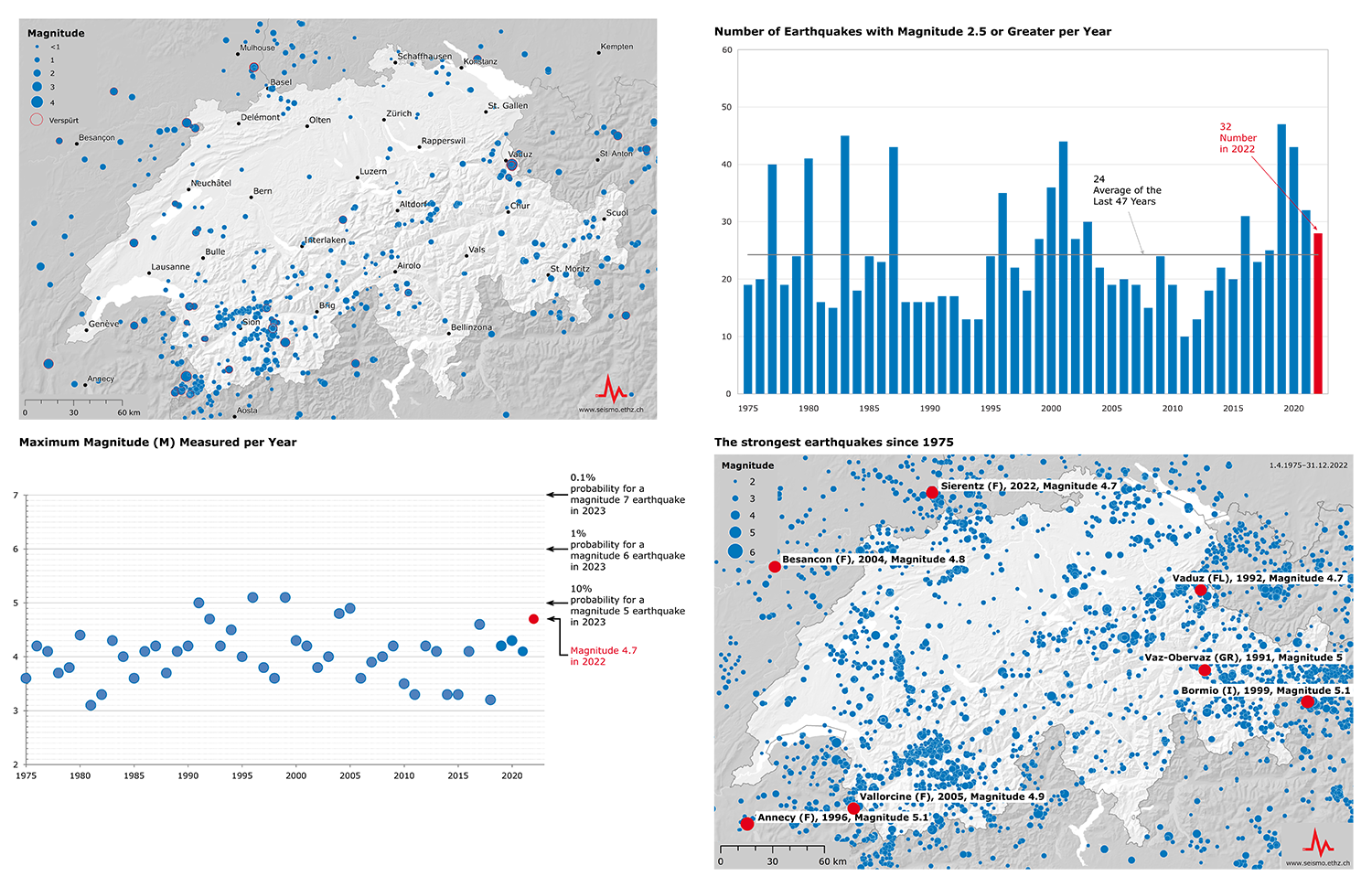2023-02-01
Earthquakes in Switzerland in 2022
The Swiss Seismological Service (SED) at ETH Zurich recorded around 900 earthquakes last year. Earthquake activity was particularly characterised by events in neighbouring countries, such as the quake near Sierentz (France). With a magnitude of 4.7, this was the fifth strongest earthquake in the recording area since the introduction of modern measurement methods in 1975. The tremors were felt over a wide area. Quakes near Albstadt (Germany), Chamonix (France) and Triesenberg (Liechtenstein) as well as in Haute-Ajoie (canton of Jura) were also clearly felt.
Read more...With around 900 earthquakes recorded, the number of events was slightly lower than in previous years. Of these, 28 (slightly more than the long-term average) had a magnitude of 2.5 or above. Quakes in this range are likely to be felt by the population. Unlike some other years, there were no significant earthquake sequences in 2022, which is a major reason why the number of quakes was somewhat lower. Such fluctuations in earthquake activity are normal and do not allow conclusions to be drawn about future developments.
The quake near Sierentz in Alsace (France) on 10 September 2022 was the fifth strongest event in Switzerland or its neighbouring regions since the start of modern instrumental earthquake recording in 1975. It had a magnitude of 4.7 and was felt in large parts of Switzerland. The SED received 11,000 felt reports from the general public – the highest number to date. This event shares fifth place with an earthquake of the same magnitude that occurred near Vaduz (Liechtenstein) in 1992. The largest earthquakes in Switzerland or neighbouring countries since 1975 happened near Annecy (France) in 1996 and close to Bormio (Italy) in 1999, both with a magnitude of 5.1. Next strongest, with a magnitude of 5.0, is the last damaging earthquake to have had its epicentre in Switzerland, hitting Vaz (canton of Grisons) in 1991. This is followed by an earthquake near Vallorcine (France) (2005, magnitude 4.9) and one near Besançon (France) (2004, magnitude 4.8).
The Sierentz earthquake was linked to a well-known, seismically active tectonic structure, the Rhine Graben, which extends north from the Basel region, between the Black Forest and the Vosges mountain range. Earthquakes are not uncommon in this region, but quakes of a magnitude similar to that experienced last September happen only about once every 10 to 20 years. Historically, large damaging earthquakes have also been documented in this area, such as the one near Basel in 1356 with a magnitude of 6.6. In the centuries that followed, a damaging earthquake occurred about every 50 to 100 years, but since 1650 there have been only a few larger quakes. However, historical evidence and palaeoseismological studies suggest that a quake of similar strength to the one in 1356 can be expected in the region every 2,000 to 2,500 years.
The epicentre of the second largest earthquake in 2022 was near Triesenberg (Liechtenstein). With a magnitude of 3.9, it could be clearly felt not only throughout Liechtenstein but also in Switzerland, as far away as St Gallen and Chur. Of the more than 700 felt reports, some also came from the regions of Schaffhausen, Zurich and Lucerne. The earthquake occurred close to the Earth's surface, meaning that it was felt quite strongly right at the epicentre, but relatively weakly further away. Around 20 seconds before the main tremor on 1 September, there was a 2.1-magnitude foreshock, which was also clearly felt near the epicentre. There followed numerous aftershocks, some of which were perceptible. The largest of these, with a magnitude of 3.1, happened on 14 October. Like the Rhine Graben, the St Gallen Rhine Valley is one of the areas in Switzerland with a relatively high risk of earthquakes. Also clearly perceptible in adjoining parts of Switzerland were a 4.2-magnitude quake near Albstadt (Germany) on 9 July and one near Chamonix (France) with a magnitude of 3.7, which occurred on 25 September.
As well as these quakes in neighbouring countries, a magnitude-3.1 aftershock from the earthquake sequence in Haute-Ajoie (canton of Jura) was clearly felt, especially in the Jura. This sequence began in late 2021. There was also a magnitude-1.6 earthquake near Monthey (canton of Valais) on 25 October, prompting an unusually large number of felt reports. People cannot normally feel an earthquake of this magnitude. The reasons why this quake was clearly perceptible were the time at which it occurred, in the late evening, and its shallow focus, about one kilometre below the Earth's surface.
Fortunately, of the five largest quakes since the instrumental measuring network was established, only the one near Vaz caused (minor) damage in Switzerland. Damaging earthquakes are therefore rare, but they are bound to occur in the future. Until now, little has been known about the effects that earthquakes could have on people and buildings today. In the future, it will be possible to estimate these impacts using the first publicly accessible – and, to date, most reliable – seismic risk model for Switzerland. The model, developed by the SED in cooperation with the Federal Office for the Environment (FOEN), the Federal Office for Civil Protection (FOCP), EPFL and other partners from industry, will be presented to the public on 7 March 2023.
